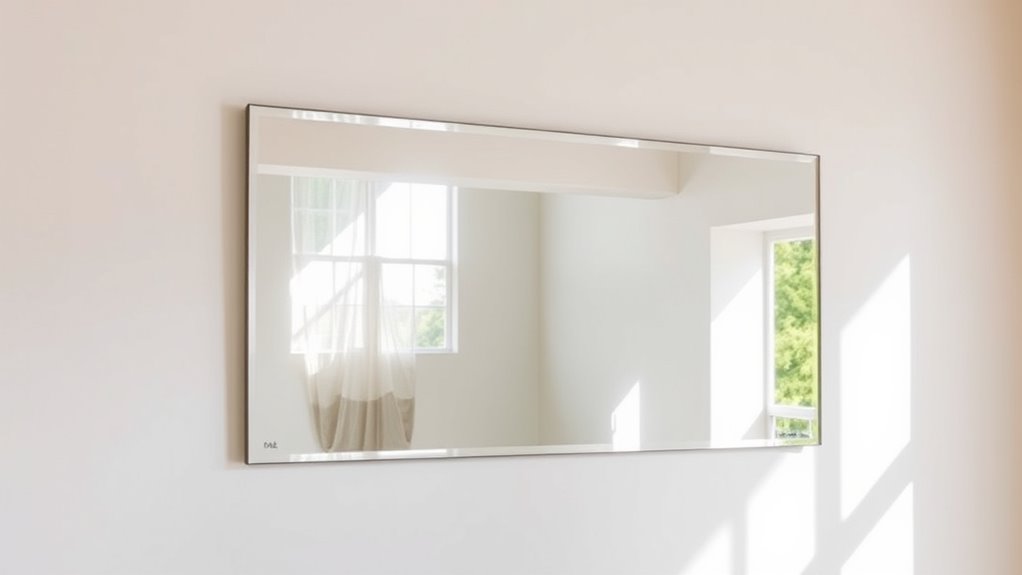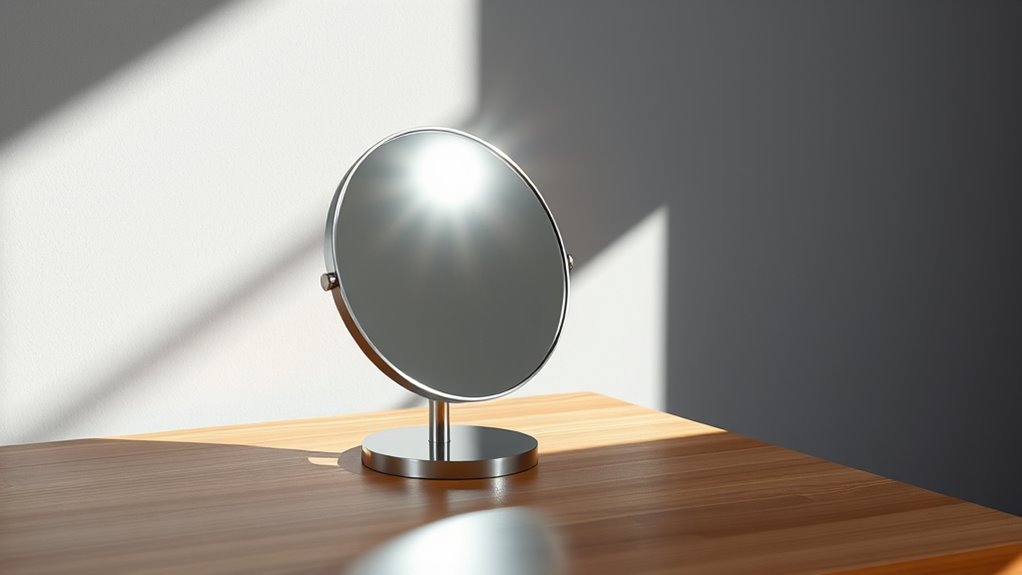To double the light in your space, position mirrors directly opposite windows or light sources so they reflect maximum sunlight. Use large or multiple mirrors to spread brightness evenly throughout the room. Adjust angles slightly to redirect light into darker corners. Consider placing mirrors near reflective surfaces or architectural features for added depth. Keep mirrors clean and clutter-free for ideal reflection. If you keep experimenting with placements, you’ll discover even more ways to brighten your space.
Key Takeaways
- Position mirrors directly opposite windows or light sources to maximize natural light reflection and amplify brightness.
- Use multiple mirrors across from windows to create layered reflections that enhance overall illumination.
- Choose appropriately sized and shaped mirrors to suit the space, making smaller rooms appear larger and brighter.
- Keep mirrors clean and well-maintained to ensure maximum reflectivity and light doubling efficiency.
- Incorporate decorative frames and strategic placements to increase visual interest and optimize light flow throughout the room.
Choosing the Right Mirror Size and Shape

Choosing the right mirror size and shape is essential for both functionality and style. When selecting a mirror, consider decorative frame choices that complement your room’s decor, adding personality and elegance. The frame’s style can range from sleek and modern to ornate and vintage, so pick one that enhances your space. Additionally, pay attention to mirror placement height—placing it too high or low can diminish its effectiveness and disrupt visual balance. A well-sized mirror should suit the wall it’s on; a large mirror can make a small room feel bigger, while a smaller one works well for accent spots. Considering mirror placement and size helps optimize light reflection and room perception. The right combination of size, shape, and decorative frame choices guarantees your mirror enhances your space while doubling light and creating a welcoming atmosphere.
Placing Mirrors Opposite Windows for Maximum Light Reflection

Have you ever noticed how a mirror placed opposite a window can brighten a room instantly? To maximize this effect, position your mirror directly facing the window, so natural light reflects deep into the space. Consider these tips for ideal placement:
- Use decorative framing to enhance aesthetic appeal and draw attention to the mirror.
- Keep the mirror clean; smudges and dust can diminish its reflective power.
- Adjust the angle if needed, ensuring the light bounces effectively without glare or distortion.
- Experiment with mirror placement to find the most effective position for enhancing light reflection and overall room brightness.
Positioning Mirrors Near Light Sources to Amplify Brightness

Did you know that placing mirrors near light sources can markedly boost a room’s brightness? To do this effectively, choose decorative mirror styles that complement your space and reflect light well. Regular mirror maintenance is essential—clean the glass to prevent dust or smudges from dulling the reflection. Position the mirror so it faces the light source directly or at an angle that maximizes reflection. Keep in mind, a well-maintained mirror not only amplifies brightness but also enhances your decor’s appeal. Avoid placing mirrors too close to the light bulb or fixture, which can cause glare or damage over time. By carefully selecting your mirror style, maintaining it properly, and understanding light reflection principles, you’ll create a brighter, more inviting environment effortlessly.
Using Mirrors to Create Depth and Visual Space

Mirrors can make a room feel larger by reflecting its boundaries and opening up the space. When placed thoughtfully, they create an illusion of depth that draws the eye inward. This technique expands visual boundaries, making your environment feel more open and inviting. Incorporating vintage decor and rustic elements can further enhance the farmhouse charm while maximizing the room’s perceived openness.
Reflective Depth Enhancement
When strategically placed, mirrors can dramatically enhance the sense of depth in a space, making rooms feel larger and more open. To maximize this effect, consider the mirror material and frame styles. A glass mirror with a high-quality reflective surface provides clear, crisp reflections that deepen the visual field. Choosing frames in sleek, minimal designs or ornate styles can influence the room’s perception, adding dimension and character. For example:
- Thin metal frames create a modern, seamless look that extends space visually
- Vintage or decorative frames add layers of depth through texture and detail
- Frameless mirrors offer an unobstructed reflection, amplifying openness
- Incorporating mirror placement techniques can further optimize the perception of space and light within the room
Expanding Visual Boundaries
By strategically placing mirrors opposite each other or alongside architectural features, you can effectively expand the perceived boundaries of a room. Using decorative framing enhances the mirror’s visual appeal, making it a focal point. Mirror textures, from smooth to ornate, add depth and interest, creating illusions of space. Consider this layout:
| Wall Placement | Frame Style | Texture |
|---|---|---|
| Opposite windows | Gold ornate | Crackled finish |
| Adjacent to door | Sleek black | Frosted surface |
| Along a hallway | Vintage distressed | Beveled edges |
| Above a fireplace | Minimalist metal | Matte surface |
These choices amplify light reflection and create a sense of infinite space, transforming even small rooms into expansive areas. Incorporating unique and wicked planters can further enhance the aesthetic appeal of your space by adding greenery and style.
Experimenting With Angles to Redirect Light Effectively

Experimenting with angles is essential for redirecting light effectively, as small adjustments can substantially change where the light is directed. To achieve best results, focus on the mirror surface and fine-tune the angle calibration until you see the desired reflection. Start by slowly shifting the mirror and observe how the light shifts, making small tweaks to improve coverage.
Consider these tips:
- Adjust the mirror surface to find the ideal angle for maximum light reflection.
- Use incremental angle calibration to refine the direction precisely.
- Test different positions to see which angle best doubles the light in your space.
Strategic Mirror Placement in Small or Dark Rooms

To brighten small or dark rooms, focus on placing mirrors at ideal angles to reflect natural light effectively. Using multiple mirrors can also amplify light and make the space feel larger. Experimenting with these strategies helps you maximize illumination without taking up extra space. For better results, understand the importance of mirror placement techniques to optimize light reflection and enhance room brightness.
Optimal Mirror Angles
When placing mirrors in small or dark rooms, understanding the ideal angles can dramatically enhance light reflection and spatial perception. To maximize brightness, angle your mirror to catch existing light sources and bounce them deeper into the room. For best results, consider the mirror material, as glass mirrors with a smooth surface reflect light more effectively. Regular maintenance tips include cleaning the surface to prevent dust buildup, which can diminish reflection quality. Proper positioning involves tilting the mirror slightly upward or downward depending on the light source’s position. You can also experiment with angles to find the most suitable reflection point. Additionally, being aware of regional resource availability can help you access expert advice for optimal placement. Remember, a well-placed mirror at the right angle can make a small space feel much larger and brighter.
Reflecting Natural Light
In small or dark rooms, strategically positioning mirrors to reflect natural light can considerably brighten the space. To maximize this effect, place mirrors opposite windows or light sources to bounce sunlight throughout the room. Regular mirror maintenance guarantees your reflection remains clear and bright, avoiding dust or smudges that dull the effect. Choose decorative frames that complement your room’s style, as they can enhance the overall aesthetic while supporting your light-reflecting goals. Keep frames clean and secure to prevent shifting that might disrupt light reflection. By carefully considering placement, maintenance, and frame choices, you can effectively amplify natural light, making even small or gloomy rooms feel more open and inviting without needing additional lighting. Incorporating vertical storage solutions around your mirrors can also help maintain a clutter-free environment, further enhancing the sense of space and light.
Using Multiple Mirrors
Using multiple mirrors can dramatically enhance the brightness and perceived space in small or dark rooms by creating a layered reflection effect. To maximize this, strategically place mirrors across from windows or light sources, amplifying natural light. Keep mirrors clean through regular mirror maintenance to guarantee reflections stay bright and clear. Consider decorative frame choices that complement your room’s style, adding aesthetic appeal while serving a functional purpose.
- Use different sizes and shapes to create visual interest and depth.
- Position mirrors at varying heights for dynamic reflections.
- Maintain consistent mirror upkeep to prevent dullness and smudges.
Enhancing Natural Light With Multiple Mirror Arrangements

Arranging multiple mirrors strategically can substantially boost natural light in your space, making it feel brighter and more inviting. To maintain this effect, regular mirror maintenance is essential; clean your mirrors frequently to prevent dust and smudges from diminishing their reflective power. When choosing decorative frames, opt for styles that complement your room’s design while maximizing light reflection. Light-colored or metallic frames can help bounce daylight further, amplifying the brightness. Position mirrors opposite windows or light sources to reflect as much natural light as possible. Avoid cluttered arrangements that block light paths. Incorporating mirror placement techniques can optimize light flow and enhance the overall brightness of your environment. With thoughtful placement, proper maintenance, and stylish frames, multiple mirrors can transform your space into a brighter, more vibrant environment.
Frequently Asked Questions
How Do I Choose Mirrors That Complement My Room Decor?
When choosing mirrors that complement your room decor, consider your decor style first. For modern spaces, opt for sleek, frameless or minimalistic frames, while vintage or traditional rooms benefit from ornate or antique frames. Match the mirror’s frame materials—wood, metal, or resin—to other furniture and accents. Think about the colors and textures in your room to select a mirror that enhances your overall aesthetic seamlessly.
Can Mirror Placement Affect Room Temperature or Air Flow?
Many believe mirror placement affects room temperature or airflow, and there’s truth to it. Mirror heat reflection can cause warmer spots by bouncing back sunlight, while airflow redirection might influence how air circulates. If you position mirrors near vents or windows, they could redirect airflow or concentrate heat, subtly impacting comfort. Experiment with placements to see how mirror heat reflection and airflow redirection alter your room’s environment.
Are There Safety Concerns With Large or Heavy Mirrors?
When handling large or heavy mirrors, safety precautions are essential to prevent accidents. Always use proper lifting techniques and consider wearing gloves to protect your hands. Be cautious with heavy mirror handling to avoid dropping or damaging the glass, which could cause injury. Secure the mirror firmly during installation or transport, and if needed, seek help to manage the weight safely. Taking these steps guarantees your safety and prevents damage.
How Often Should I Clean and Maintain My Mirrors?
Ever wonder how often you should clean and maintain your mirrors? Regular mirror cleaning is essential to keep them sparkling and clear. You might consider setting a maintenance schedule—perhaps weekly or bi-weekly—based on usage and environment. This helps prevent dust, smudges, and streaks from building up. By staying consistent with your mirror cleaning routine, you’ll guarantee your mirrors stay flawless and always reflect your best image.
Can Mirrors Be Used to Improve Energy Efficiency in a Home?
Mirrors can effectively improve your home’s energy efficiency by enhancing solar heating and daylight maximization. By strategically placing mirrors, you reflect sunlight deeper into rooms, reducing the need for artificial lighting and heating. This simple adjustment helps cut energy costs and minimizes your carbon footprint. You’ll enjoy brighter, warmer spaces while conserving energy, making mirrors a smart, eco-friendly addition to your home’s design and sustainability efforts.
Conclusion
By thoughtfully placing mirrors, you transform your space into a bright, airy oasis—like turning a windowless room into a sunlit sanctuary. When you choose the right size, shape, and placement, mirrors become your secret weapon for doubling light and creating depth. Don’t be afraid to experiment with angles and positions; with each strategic move, you’re painting your room with sunlight, making every corner feel warm and welcoming.








